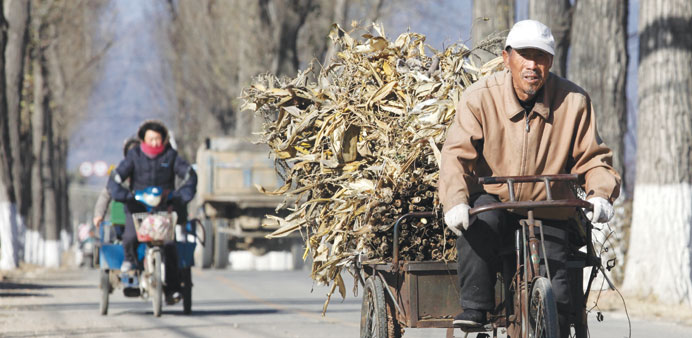A farmer cycles on a road in Pinggu, on the outskirts of Beijing. About 13% of China’s population still live on less than $1.25 per day, the UN Development Programme says. Average urban disposable income is just 21,810 yuan ($3,500) a year. Meanwhile, China has 2.7mn millionaires in dollar terms and 251 billionaires, according to the Hurun Report, known for its annual China Rich List.
Reuters/Beijing
China plans major bond market reform to raise the money the ruling Communist Party needs for a 40tn yuan ($6.4tn) urbanisation programme to buoy economic growth and close a chasm between the country’s urban rich and rural poor.
The Party aims to bring 400mn people to cities over the next decade as the new leadership of president-in-waiting Xi Jinping and premier-designate Li Keqiang seek to turn China into a wealthy world power with economic growth generated by an affluent consumer class.
The urban development would be funded by a major expansion of bond markets, sources with leadership ties, and a senior executive at one of China’s “Big Four” state banks, who was formerly at the central bank, told Reuters.
“The urbanisation drive will push the domestic capital market liberalisation agenda,” the senior bank executive said on condition of anonymity. “Urbanisation is Li Keqiang’s big project. He has to get it right and he is willing to pursue innovation to make it a success.”
Set to be confirmed as premier at the end of the annual meeting of China’s parliament, which opens next week, Li must find ways to pay for the urban development that he has made a policy priority.
Central and local governments, as well as bank loans, will fund the costs, the sources said. But, sweeping reforms to create a fully-functioning municipal bond market, boost corporate and high-yield bond issuance and actively steer foreign capital into the sector, are crucial to raising the sums of money China will need, they added.
Despite its ranking as the second-largest economy globally after three decades of stellar growth, China remains an aspiring middle-income country riven with inequality and dependent on state-backed investment.
“If we continue to walk down the path of government spending, it’ll be like wearing new shoes, but walking the old road,” a source with leadership ties said, requesting anonymity to avoid repercussions for speaking to foreign media without authorisation.
China’s economy largely relies on state-directed bank lending to fund investment projects, but the massive 40tn yuan outlay envisaged to urbanise the rural outskirts of some 270 cities is far beyond the means of the current system.
Bank credit quality was badly strained by the economic stimulus programme of 2008 that, at a headline 4tn yuan, was only a tenth the size of the urbanisation programme.
By the end of 2010, local governments had racked 10.7tn yuan of mainly bank debt to fund their commitments to the stimulus.
Total debt outstanding in China’s fledgling bond market was 26.4tn yuan as of the end of January 2013, People’s Bank of China (PBOC) data shows - barely a sixth of the size of the US bond market - and most of what is traded is issued by policy banks to support their lending.
The need for bond market reform has grown more urgent since December, when Li accelerated a commitment in China’s 12th five-year plan to spend 40tn yuan on urbanisation by 2030. That money will now be spent over the next decade.
“(Li) Keqiang changed the target date during the Central Economic Work Conference last December,” said a second source with leadership ties.
About 13% of China’s population still live on less than $1.25 per day, the UN Development Programme says. Average urban disposable income is just 21,810 yuan ($3,500) a year.
Meanwhile, China has 2.7mn millionaires in dollar terms and 251 billionaires, according to the Hurun Report, known for its annual China Rich List.

